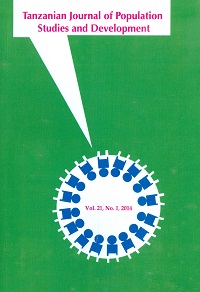Reflections on the Macro-Micro Linkages in the Analysis of Development Policy: A Developing Country Perspective
Abstract
Better understanding of the macro-micro linkages in the analyses of economic development policies, programmes and strategies is important for those poor countries that have recorded slow progress in poverty reduction after years of development initiatives and aid inflows. This paper reflects on how analyses of the policy linkages can be improved to look beyond just the economic setting of the macro-meso-micro policy channels covering policy makers and economic agents (households, firms and institutions), and include non-economic explanations of development. It is noted that quantitative (macroeconomic/microeconomic) models of development do not often capture all facilitating or inhibiting factors; hence the need to supplement the assessment by qualitative methods of analyses. The study emphasises the need for analysts to sharpen capacity in the application of "double-Q methodologies" and multi-disciplinary approaches to research and analysis of development policies and programmes.
References
Agénor, R. 2002. Quantitative Macroeconomic Analysis for the Design of Growth and Poverty Reduction Strategies - Micro-Macro Linkages for Growth and Poverty Reduction Analysis: Analytical Issues. Abidjan, April 22-May 2, 2002.
Agénor, R., & P. Montiel. 1999. Development Macroeconomics. Princeton: Princeton University Press.
Ahmed, I. 2002. Critical Issues for Developing Macro-Micro Linkages. In: UNDP (2002).
Anders, D. 2004. Growth without Poverty Reduction? Examining Micro-Macro Links in Tanzania. Forum paper on African Development and Poverty Reduction: The Macro-Micro Linkage, Lord Charles Hotel, Somerset West, South Africa, 13 €“ 15 Oct. 2004.
Bardhan, P., & C. Udry. 1999. Development Microeconomics, Oxford: Oxford University Press.
Besley, T. 2002. From Micro to Macro: Public Policies and Aggregate Economic Performance. paper presented at HM Treasury Growth Seminar, October 2000.
Bourguinon, F. 2001. Qualitative and Quantitative Approaches to Poverty Analysis: Two Pictures of the Same Mountain. In: R. Kanbur (2001).
de Janvry, A., & R. Kanbur. 2005. Poverty, Inequality and Development: Micro-macro Perspectives and Linkages. Working Paper 2005-03, Department of Applied Economics and Management, Cornell University, Ithaca, New York.
Gakusi, A., & A.N. Sindzingre. 2007. Challenges and Opportunities of Evaluation in Fostering Development in Sub-Saharan Africa. Paper for African Economic Conference, African development Bank and economic Commission for Africa, Addis Ababa, 15-17 November 2007.
Goldman I. 2000. Micro to Macro: Policies and Institutions for Empowering the Rural Poor. www.livelihoods.org/info/docs
Gunter B.G., M.J. Cohen, & H. Lofgren. 2005. Analyzing Macro-Poverty Linkages: An Overview. Development Policy Review, 2005, 23 (3): 243-265.
Handa, S. 2003. Adjustment with a Human Face: Evidence from Jamaica. World Development. Vol. 31, No. 7 pp. 1125-1143.
Harris, J., J. Hunter, & C.M. Lewis (eds). 1997. The New Institutional Economics and Third World Development. Rutledge: London.
Hartog, J. 2005. Analysis of the NSGRP Consultation Process. Draft report, The Netherlands Development Organisation (SNV).
Jolly R., A. Cornea, & F. Stewart. 1987. Adjustment with a Human Face Protects Vulnerable Groups. Oxford: Oxford University Press.
Kanbur, R. (ed). 2001. Q-Squared: Qualitative and Quantitative Methods of Poverty Appraisal. New Delhi: Permanent Black.
Kousari K. 2002. Structural Adjustment and Poverty Reduction in Africa. Based on UNCTAD. 2002. From Adjustment to Poverty Reduction: What is New? (UNCTAD /GDS/AFRICA/2).
London A.S., S. Schwartz, & E.K. Scott. 2005. Combining Quantitative and Qualitative Data in Welfare Policy Evaluation in the United States. Q-squared Working Paper No. 12, Centre for International Studies, University of Toronto.
ODI. 2003. Making the Link Between Micro and Meso: Learning from Experience on Community-Based Planning (CBP) - CBP Partners in Ghana, Uganda, South Africa and Zimbabwe, London: Oversees Development Institute.
Ponthagunta S. 2002. SAPAP: Macro-Micro Perspectives. In: UNDP. (2002).
Rusnak G., L. Savard, R. Schmidt, & R. Spence. 2000. The Micro Impacts of Macroeconomic and Adjustment Policies, (MIMAP). Prospectus 2000 €“2005, IDRC/CRDI.
Sadoulet, E., & A. de Janvry. 1995. Quantitative Development Policy Analysis. Baltimore: Johns Hopkins University Press.
UNDP. 2002. Assessing Linkages Between Micro and Macro Level Issues. UNDP Workshop Proceedings. New Delhi, February 2002.
€”. 2003. Assessment of Micro-Macro Linkages in Poverty Alleviation: Country Cases: Bangladesh, India, Nepal, Pakistan and Sri Lanka New York: United Nations Development Programme Evaluation Office.
United Republic of Tanzania (URT). 2005. National Strategy for Growth and Reduction of Poverty. Dar es Salaam, Vice President ' s Office, Poverty Eradication Division.
World Bank. 2002. Micro-Macro Linkages in the Design of Growth and Poverty Reduction Strategies. World Bank Training Seminar organized by the World Bank Institute and the Poverty Reduction and Economic Management (PREM) Network, Washington DC, February 19-22, 2002.


